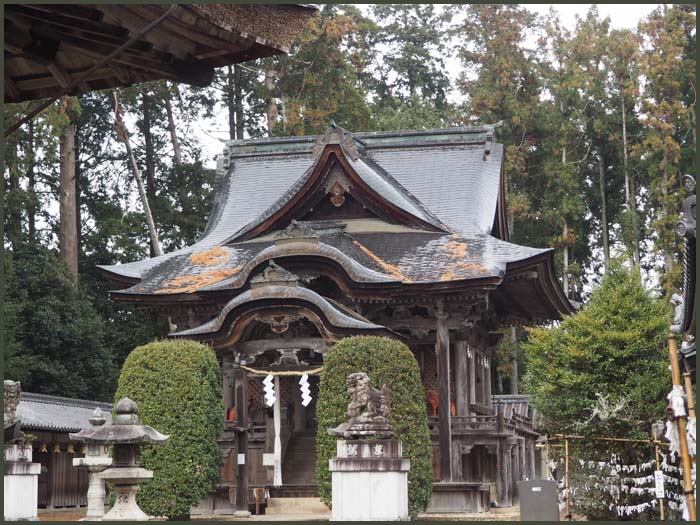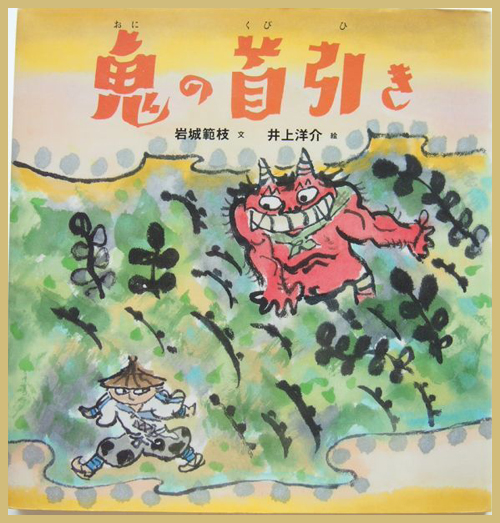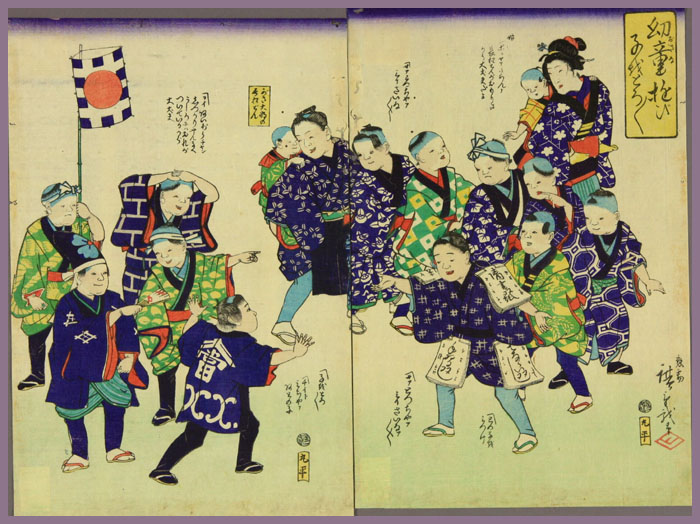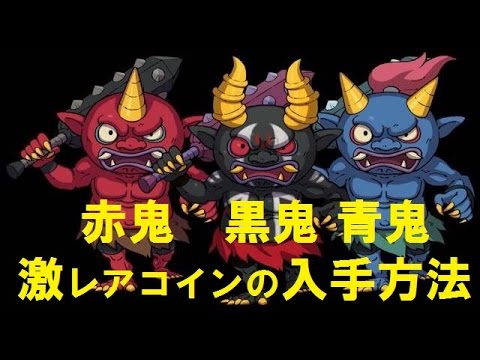[ . BACK to DARUMA MUSEUM TOP . ]
. Onipedia - 鬼ペディア - Oni Demons - ABC-List - .
:::::::::::::::::::::::::::::::::::::::::::::::::::::::::::::::::::::::::::::::::::::::::::::::::::::::::::::::::::::::::::::::::::::::::::::::::::::::::::::::::::::::::::::::::::
Shiga 滋賀県の鬼伝説 Oni Demon Legends
Have a drink with Oni beer while you read this!
 「青鬼ピルスナー」Blue Demon and 「赤鬼レッドエール」Red Demon
「青鬼ピルスナー」Blue Demon and 「赤鬼レッドエール」Red Demon
..............................................................................................................................................
The most well known story is about Shuten Doji and the Demons of Oeyama.
. Shuten Dooji 酒呑童子 Shuten Doji "Sake Child" Demon
Shuten Dōji 酒顛童子, 酒天童子, 朱点童子 Saka Doji / "Demon Child" 鬼童 Kido .
Kidoomaru 鬼童丸、鬼同丸(きどうまる)
Kidomaru
It is related to the famous demons of
Oeyama 大江山.
And
Minamoto no Yorimitsu 源頼光 (948 – August 29, 1021), also known as
Minamoto no Raikō
Oni no dookutsu 鬼の洞窟 Oni’s cave
Oni-take Inari Jinja (鬼岳稲荷神社)
Oni-iwa 鬼岩 Demon boulder - Hyogo
鬼越山 Onigoeyama - Ibaraki
Watanabe no Tsuna 渡辺綱 (953-1025) fights against a demon (Ibaraki doji)
鬼殺し Onikoroshi " killing the demon" - Sake
The demon 外道丸
Gedomaru lived a while at the foot of Mount Ibukiyama 伊吹山の麓 as 伊吹童子 Ibuki Doji and then moved on to Oeyama.
.......................................................................
dooji kirimaru 童子切丸 Doji Killer Blade
Name of the sword from
Minamoto Raiko, used to kill 伊吹童子 Ibuki Doji.
(Below, there are other famous swords called
Kirimaru.)

最上家伝来の宝刀「鬼切丸」/ Onimaru 鬼丸 - -
Oni Kirimaru - "Demon cutter" of the Mogami clan
源氏重代の宝刀の一つ鬼切
- reference source : samidare.jp/yoshiaki -
The elder brother of Raiko, 美女丸 Bijomaru,
took the sword and became quite wild. His father 源光仲 Mitsunaka ordered 藤原仲光 Fujiwara no Nakamitsu to kill Bijomaru, but Nakamitsu killed his own son instead and presented it to Bijomaru. Bijomaru finally changed his wild ways and became a monk at 比叡山 Hieizan.
- quote -
美女丸 Bijomaru and 幸寿丸 Kojumaru (小童寺 Shodoji Temple)
There is a tragic tale told of Shodoji Temple located in Nishiuneno.
Minamoto-no-Mitsunaka, who was the Lord of Settsu and the person who built Tada-In (Tada Shrine) in the 10th century, sent his son, Bijomaru, to Nakayamadera Temple (Takarazuka City, to receive training to become a Buddhist priest. Bijomaru, however, spent all his time playing martial arts, and was not serious at all in his training to become a priest.
One day, when Bijomaru became 15 years old, his father, Mitsunaka asked him how much progress he made in his training. When Mitsunaka realized that Bijomaru could not read Buddhist scriptures, nor compose a tanka (a 31-syllable Japanese poem) nor play music, he became furious and ordered his chief vassal, Nakamitsu Fujiwara, to kill Bijomaru by cutting his head.
Nakamitsu was in big difficulties, since he could not take the life of a son of his lord.
As Kojumaru, one of the sons of Nakamitsu, knew the plight of his father, he told his father to kill him instead. Nakamitsu found Kojumaru join his hands in prayer, and close his eyes. Holding back his tears, Nakamitsu slew his son, and let Bijomaru secretly go off to Mount Hiei (Shiga Prefecture).
Bijomaru later found out what had happened, and devoted himself to ascetic practices to become a priest. He became a high-ranking priest, called
Genken-sozu, and built Shodoji Temple to enshrine the spirit of Kojumaru.
The temple of this legend is highlighted by ever-changing scenery of the seasons, from cherry blossoms in spring to vibrant yellows and reds in autumn.
- source : city.kawanishi.hyogo.jp -
 source : MUROMACHI Nakayo
美女丸と幸寿丸
source : MUROMACHI Nakayo
美女丸と幸寿丸
- A friend remarked:
... about Minamoto no Yorimitsu (raiko) and his father Mitsunaka ...
... until 1068 this family was 摂関 Sekkan (Sesshō+Kampaku), after it was Go-Sanjō-tennō (71th) and they took back the dictature until 1185
- anyway it means they were the highest level in the hierarchy
and the Minamoto-shi was Chinjufu-shōgun (so kokushi) meaning vassal of all the people of Fujiwara-shi.
So as the nippon-no-rekishi is very complex, this story is tricky, as a Fujiwara cannot be in the service of a Minamoto.
Any answers to this?
..............................................................................................................................................
hebi kirimaru 蛇切丸 serpent cutter sword
Niigata, 松之山町
Matsunoyama
The serpent wanted the princess of the pond 蒲生池 / 蒲生の池 Kamo-no-ike as his bride. But the Nakodo was refused. In his anger he killed all the members of the family.
He borrowed the famous serpent-cutting sword
Hebikirimaru 蛇切丸 and fought with the enemy.
. nakōdo 仲人 Nakodo, legends about matchmakers .

宝剣蛇切丸 宇佐神社 Usa Jinja, Kagawa, Sanuki town

歌川芳艶 Utagawa Yoshitsuya (1822 - 1866)
.......................................................................
kumo kirimaru 蜘蛛切丸 spider cutter, spider-killing sword
The sword Kimaru,
Onimaru 鬼丸 used to kill the Tsuchigumo monster 土蜘蛛退治.
This sword is also called
Hizamaru (膝丸)
- quote -
There are various theories to the story of the tsuchigumo, and in the Heike Monogatari, there is as following (they were written as 山蜘蛛).
When Yorimitsu suffered from malaria, and lay on a bed, a strange monk who was 7 shaku (about 2.1 meters) tall appeared, released some rope, and tried to capture him. Yorimitsu, despite his sickness, cut him with his famous sword, the Hizamaru (膝丸), causing the monk to flee. The next day, Yorimitsu led his Four Guardian Kings to chase after the blood trail of the monk, and arrived at a mound behind shrine Kitano jinja where there was a large spider that was 4 shaku wide (about 1.2 meters). Yorimitsu and the others caught it, pierced it with an iron skewer, and exposed it to a riverbed. Yorimitsu's illness left him immediately, and the sword that cut the spider was from then on called the
Kumo-kiri (蜘蛛切り, spider-cutter).
The true identity of this tsuchigumo was said to be an onryō of the aforementioned local clan defeated by Emperor Jimmu.
This tale is also known from the very fifth noh, "Tsuchigumo."
- source : wikipedia -

歌川国義 Utagawa Kuniyoshi
- quote -
the sword Onimaru 鬼丸
Onimaru is one of the 'Tenka-goken', the five famous swords of Japan.
Its legend is about an ogre which made Hojyo Tokiyori, 5th regent in Kamakura era, suffer from nightmares. One night, he saw a dream of an old man, who turned out to be a spirit of the katana. After following the his advice in real world, the katana fell down and cut down the silver decoration of an ogre.
Since then, he never saw a nightmare again.
Imperial Household Agency is currently keeping this Onimaru. Unfortunately, it has only been displayed three times.
- source : wasa-bi.com/topics -
:::::::::::::::::::::::::::::::::::::::::::::::::::::::::::::::::::::::::::::::::::::::::::::::::::::::::::::::::::::::::::::::::::::::::::::::::::::::::::::::::::::::::::::::::::
kishin 鬼神 "Demon Deity"
Once
Fujiwara no Chikata used his four Demon Deities to haunt travellers in the region.
But Tamuramaro came to punish him.
. Sakanoue no Tamuramaro 坂上田村麻呂 (758 - 811) .
... a general and shogun of the early Heian Period of Japan.
Fujiwara no Chikata no Yonki 藤原千方の四鬼 The four demons of Fujiwara Chikata
 - quote -
Fujiwara no Chikata - kutsu 窟 cave (Takao, Iga City)
- quote -
Fujiwara no Chikata - kutsu 窟 cave (Takao, Iga City)
This is the castle of Fujiwara no Chikata, who appears in the Taiheiki, or Records of Great Peace.

In the Heian Period, noble family Fujiwara no Chikata started war with the imperial court, used the
yonki (four devils: kinki 金鬼 gold devil, fuuki 風鬼 wind devil, suiki 水鬼 water devil,
ongyoki 隠形鬼 / 怨京鬼 stealth devil, invisible devil)
to distress the imperial armies.
The waka poem of 紀朝雄 / 紀友雄 Kinotomo, who had come to put down Fujiwara no Chikata, said
“All things, whether grass or tree, are ruled by the Emperor,
and not even a devil can turn his back to the Emperor and live in this land”
to disperse the four devils and Fujiwara no Chikata was defeated. The four devils are said to have been the original archetype for ninja.
The Chikata monument was built in 1760, and commemorates Fujiwara no Chikata and Wakamiya deities.
- source : iganinja.jp/en/place/spo -
(Others say these devils have been
kori 狐狸 foxes or badgers.)
 - - - More in the Japanese WIKIPEDIA !
. kitsune to oni 狐と鬼 伝説 Legends about fox and demon .
- - - More in the Japanese WIKIPEDIA !
. kitsune to oni 狐と鬼 伝説 Legends about fox and demon .
.............................................................................................................................................
kijin 鬼人 "human demon"
Once upon a time
King Ashoka (阿育王 Aiku-O) from India asked a human demon to throw three rocks to 琵琶湖 lake Biwako in Japan.
This is the beginning of an island called Shiraishi 白石島 "white stone island".
 沖の白石 Oki no Shiraishi - rocks in the middle of Lake Biwako
沖の白石 Oki no Shiraishi - rocks in the middle of Lake Biwako
There are now four rocks, sticking out from about 80 meters below the water level.
Now a favorite resting place for birds, which turned the rocks white from bird droppings.
..............................................................................................................................................
蒲生郡
Gamou district 日野町
Hino
At the shrine 綿向神社
Watamuki Jinja there is an ema 絵馬 votive tablet of a half-naked woman, only clad in
koshimaki 腰巻 waste wrapper, and an Oni with only a
fundoshi 褌1丁 male underware doing a bout of 相撲 sumo wrestling.
- If any one can locate this ema, please share ! -
 馬見岡綿向神社 Umamioka Watamuki Jinja
馬見岡綿向神社 Umamioka Watamuki Jinja
滋賀県蒲生郡日野町村井711 / 711 Murai, Hino-chō, Gamou-gun, Shiga
- quote -
Umamioka Watamuki Shrine at the foot of Mt. Watamuki in Hino Town, Shiga Prefecture, is a historic shrine founded in 545. The enshrined deities are Amenohonohi no Mikoto, Amenohinadori no Mikoto and Takemikumaushi no Mikoto.
It was originally founded at the top of Mt. Watamuki and was transferred to the present place in 796.
The spring festival of the shrine
"Hino Festival” held on May 2 to 4 every year is the most gorgeous festival on the eastern side of Lake Biwa. The festival dates back to 1170, since when ancient rituals and customs have been passed down to the present time.
On the main festival day on May 3,
a lot of Shinto rites are performed in traditional ways. The highlight is the parade with the 3 holy children and the guarding attendants in samurai costumes in the lead, who are followed by a sacred horse, shrine priests and the 3 mikoshi from the attached shrines and sumptuous 16 festival floats, which were donated by wealthy Omi merchants about 130 to 200 years ago. The festival is prefecturally designated as an intangible cultural property.
- source : nipponkichi -
..............................................................................................................................................
伊香郡
Ika district 西浅井町
Nishiazai
kimon 鬼門,忌門 the Demon gate
When building a new home, people have to take great care in the Northern direction .
. kimon 鬼門 the Demon Gate .
The north is considered an un-auspicious region and needs protection from real and imagined enemies, fiends and demons.
.......................................................................
甲賀市
Koga town 甲南町
Konan
oniban 鬼 / オニバン
Ganzan Daishi was explaining the sutras. To drive out the
akuma 悪魔 devil he transformed himself into an Oni.
Amulets with this figure are now used for healing purposes (病気平癒・虫除け).
 . Ganzan Daishi, Gansan Daishi 元三大師 .
. Ganzan Daishi, Gansan Daishi 元三大師 .
Ryōgen 良源 Priest Ryogen (912 – 985)
............................................................................................................................................
大津市 Otsu
. Otsu-E 大津絵 Oni Paintings from Otsu - Gallery .
Oni no nenbutsu, nembutsu 鬼の念仏 Demon saying Amida prayers
鬼の寒念仏 demon praying in the cold and more Oni motives .
.......................................................................
At the temple 明王院 Myo-O-In in the village of 葛川 Kuzugawa there is an ema 絵馬 votive tablet showing an
aka-oni 赤鬼 red demon with white fundoshi ふんどし underpants and a waist wrapper made from 豹の毛皮 panther skin. His opponent is a huge man with strong muscles, all naked. They have a rope around the neck
kubihiki 首引き and pull in a contest of strength, a kind of
"Neck tug of war".
.......................................................................
kishin 鬼神 "Demon Deity" - waka no toku 和歌の徳 -
At Karasaki there is a famous 唐崎の松 matsu pine tree.

Once it was about to wither but through the power of Waka poetry the Kishin was moved and helped it to regain its lush green color.
. Matsuo Basho visiting Karasaki .
The pines of Karasaki are another of the famous eight landscapes of Omi (omi hakkei 近江八景) Eight Views of Omi Province.
............................................................................................................................................
高島市
Takashima town
ura kimon 裏鬼門 the back-side kimon deomn gate
The kitchen entry and main pillar of the home are the KIMON.Taking the opposite direction is the
ura kimon.
There in the garden you should not plant anything, because that will cause bad luck.
.......................................................................
高島郡
Takashima district マキノ町
Makino
onibaba 鬼婆 demon hag
She invites travellers to stay over night in her home and then kills and eats them.
:::::::::::::::::::::::::::::::::::::::::::::::::::::::::::::::::::::::::::::::::::::::::::::::::::::::::::::::::::::::::::::::::::::::::::::::::::::::::::::::::::::::::::::::::::
- reference : Nichibun Yokai Database -
- reference - 滋賀県の鬼 -
:::::::::::::::::::::::::::::::::::::::::::::::::::::::::::::::::::::::::::::::::::::::::::::::::::::::::::::::::::::::::::::::::::::::::::::::::::::::::::::::::::::::::::::::::::
. Sumoo 相撲 Sumo wrestling - Introduction .
sumoo 鬼の相撲 Sumo wrestling of the Demons

地獄谷 鬼と熊の相撲 Oni and a bear doing a bout of Sumo at a hot spring in Noboribetsu, Hokkaido.
.......................................................................
群馬県
Gunma 草津
the hot spring of Kusatsu
Oni no Sumoba 鬼の相撲場 The Devil's Sumo Ring

 source : blog.livedoor.jp/kusatsu932
source : blog.livedoor.jp/kusatsu932
..............................................................................................................................................
岐阜県
Gifu 和良村
Waramura
Once upon a time at night, 赤鬼と青鬼 the red Oni and the blue Oni were doing a bout of Sumo near a cliff.
The red Oni fell down. When the villagers looked the next morning, there was a dead human.
This must have been the bad doing of a fox.
..............................................................................................................................................
山形県
Yamagata 真室川町
Mamurogawa
Once upon a time a husband went hunting at night. When he came back he found that his pregnant wife had been eaten by an 鬼婆 Onibaba Hag. But she had not eaten the baby in her belly. The child grew up to become a big, strong man. He went after the Onibaba, gave her iron bullets to eat and killed her. Finally he had taken revenge at the enemy of his mother !
They say he was the ancestor of Sumo wrestlers.
And the Onibaba turned out to be a dead fox.
..............................................................................................................................................

鍾馗と鬼の相撲
Shoki and the Demon doing a bout of Sumo.
. Shooki 鍾馗 Shoki The Demon Queller .
..............................................................................................................................................
- reference : Nichibun Yokai Database -
:::::::::::::::::::::::::::::::::::::::::::::::::::::::::::::::::::::::::::::::::::::::::::::::::::::::::::::::::::::::::::::::::::::::::::::::::::::::::::::::::::::::::::::::::::
kubihiki 鬼の首引き neck tug of war of the demons - a special kind of Sumo

This is maybe the first children's book where 鬼の娘
the daughter of an Oni is the hero. She was supposed to have her first meal of a human 「お食い初め」and the story tells about the ruses the human, a young man, who tries to survive. He has to win a neck tug of war with many Oni.
Text by 岩城範枝 / Illustrations by 井上洋介
.......................................................................
Yanagi Soetsu Muneyoshi 柳宗悦 (1889-1961)
wrote about 大津絵 Otsu-E paintings and Oni at the rituals during Setsubun 追分絵.
One of them was the neck tug of war.
..............................................................................................................................................
福島県
Fukushima いわき市
Iwaki
At the 住吉神社
Sumiyoshi Shrine there is an ema 絵馬 votive tablet.
On the left side of the rope sits a strong man with a sword at his side, and a hachimaki 鉢巻 headband.
On the right side sits an Oni with protruding eyes.
..............................................................................................................................................
朝比奈義秀の鬼の首引き Asahina Yoshihide
. Asahina Saburo Yoshihide - 朝比奈三郎義秀 - 13th century .
Asahina's name is associated with some incredible feats.


- More ONI carvings on this festival float 「だるま連」屋台彫刻 :
正面鬼板・懸魚「鍾馗の鬼退治」
- reference source : asdk.sakura.ne.jp/fukude -
.......................................................................
 source : hokuriku.my-fav.jp/event
source : hokuriku.my-fav.jp/event
俵屋宗達
Tawaraya Sotatsu (around 1620)
.......................................................................

武士と鬼の首引
Bushi and Oni Kubihiki
and
Bushi and Tengu Sumo 武士と天狗の相撲
菱川師宣 Hishikawa Moronobu (around 1695)
..............................................................................................................................................
- reference : Nichibun Yokai Database -
:::::::::::::::::::::::::::::::::::::::::::::::::::::::::::::::::::::::::::::::::::::::::::::::::::::::::::::::::::::::::::::::::::::::::::::::::::::::::::::::::::::::::::::::::::
 . - - - Join the Onipedia friends on facebook ! - - - .
. - - - Join the Onipedia friends on facebook ! - - - .
:::::::::::::::::::::::::::::::::::::::::::::::::::::::::::::::::::::::::::::::::::::::::::::::::::::::::::::::::::::::::::::::::::::::::::::::::::::::::::::::::::::::::::::::::::
. Onipedia - 鬼ペディア - Oni Demons - ABC-List - .
. Tengu 天狗と伝説 Tengu legends "Long-nosed Goblin" .
. - yookai, yōkai 妖怪 Yokai monsters - .
. Legends and Tales from Japan 伝説 - Introduction .
. Mingei 民芸 Regional Folk Art from Japan .
:::::::::::::::::::::::::::::::::::::::::::::::::::::::::::::::::::::::::::::::::::::::::::::::::::::::::::::::::::::::::::::::::::::::::::::::::::::::::::::::::::::::::::::::::::
[ . BACK to DARUMA MUSEUM TOP . ]
[ . BACK to WORLDKIGO . TOP . ]
- #shigademons #shiga #onikirimaru #shutendoji #onikubihiki #onisumo -
:::::::::::::::::::::::::::::::::::::::::::::::::::::::::::::::::::::::::::::::::::::::::::::::::::::::::::::::::::::::::::::::::::::::::::::::::::::::::::::::::::::::::::::::::::
















































